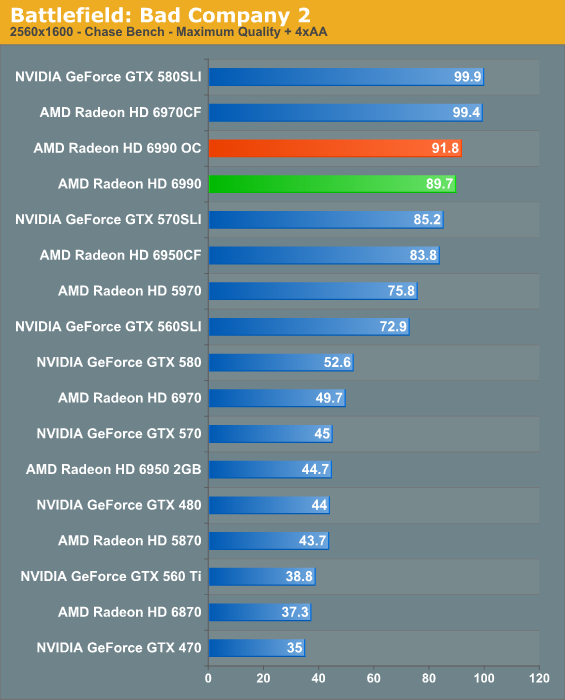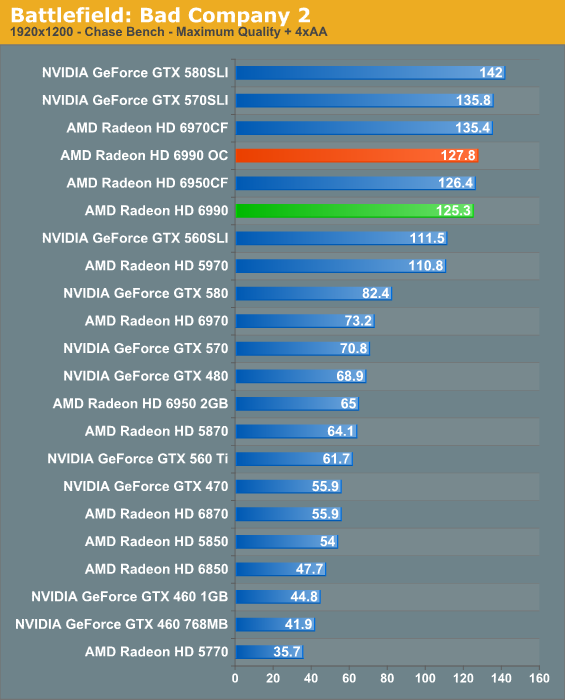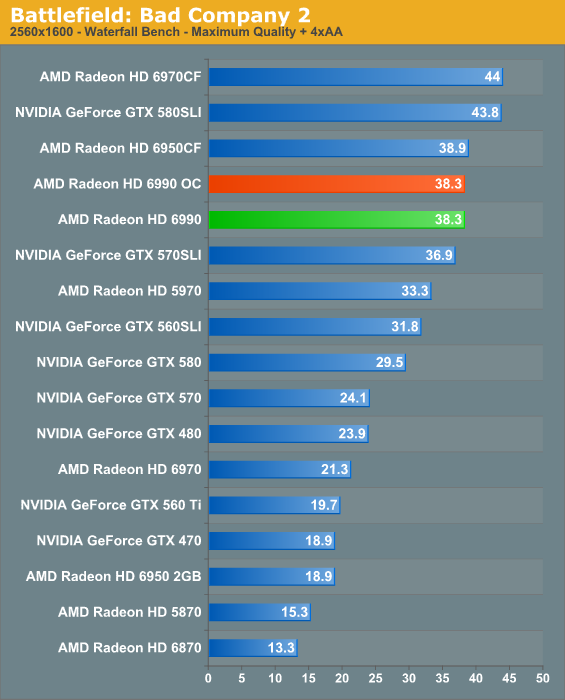AMD's Radeon HD 6990: The New Single Card King
by Ryan Smith on March 8, 2011 12:01 AM EST- Posted in
- AMD
- Radeon HD 6990
- GPUs
Battlefield: Bad Company 2
The latest game in the Battlefield series - Bad Company 2 – remains as one of the cornerstone DX11 games in our benchmark suite. As BC2 doesn’t have a built-in benchmark or recording mode, here we take a FRAPS run of the jeep chase in the first act, which as an on-rails portion of the game provides very consistent results and a spectacle of explosions, trees, and more.


Bad Company 2 ends up being another game heavily reliant on memory bandwidth, so once again the 6970CF takes a solid lead over the 6990, effectively matching the 10% memory bandwidth difference with 10% more performance. Interestingly the 6990 still has an edge on the 6950CF, showing that there’s more than 1 bottleneck with Bad Company 2. Meanwhile compared to the 5970 the 6990 once again takes a respectable lead of 18%. AMD is fortunate here though that the Radeons have an advantage in this game, as giving up 10% in performance almost anywhere else would be enough to fall below the GTX 570 SLI.

Our waterfall minimum framerate benchmark ends up being quite similar in order to our general chase benchmark. The 6990 is noticeably behind the 6970CF, and in fact it’s just a bit worse this time as the 6950CF edges out even the 6990OC. Memory bandwidth and PCIe bandwidth, take your pick, both play a part here.










130 Comments
View All Comments
ET - Tuesday, March 8, 2011 - link
If you're going to keep your case open all day with your ear to the graphics card, then you might get that 70dB+, which won't be too nice on the ear. On the other hand you won't get much gaming done. :)I don't know the exact distance Anandtech measured this noise at, but Kitguru measured at about 1 metre and got 48dB when running Furmark, 40dB for normal load.
bobsmith1492 - Tuesday, March 8, 2011 - link
70dB is very low and only would apply if you are essentially living next to your computer - that's a 24-hour exposure level.NIOSH recommends 85dB as the upper limit for 8 hours of exposure, with a 3dB exchange rate - that is, every time you halve the amount of time you're exposed to the sound you can increase the volume by 3dB.
http://www.cdc.gov/niosh/docs/96-110/appF.html
looniam - Wednesday, March 9, 2011 - link
*ahem*"The document identifies a 24-hour exposure level of 70 decibels as the level of environmental noise which will *prevent* any measurable hearing loss over a lifetime"
does NOT say what the maximum is.
from my experience as an audio tech:
95dB is the start of temporary hearing loss, 110dB is the start of permanent and 140dB is the threshold of pain.
and for drunk people, they can't hear anything below 150dB :)
Ninjahedge - Thursday, March 10, 2011 - link
What?futuristicmonkey - Tuesday, March 8, 2011 - link
Any chances for some memory OC benches?nitrousoxide - Tuesday, March 8, 2011 - link
Both AMD and nVidia are out of mind, they are ignorant of the consequence by putting two gigantic chips with 5+billion transistors on the same board. I can't find the point of buying such outrageous card instead of building a CFX/SLI system. At least the latter isn't that loud, isn't that hot and consumes hardly more power than those monstrosities.TSMC is to blame. They dropped 32nm so it is impossible to get 6990/590 within 300W power envelope. But neither AMD nor nVidia turn back, but keep making these non-sense flagship cards.
Figaro56 - Tuesday, March 8, 2011 - link
No, it's not.Amuro - Tuesday, March 8, 2011 - link
I will be water cooling them! :)nitrousoxide - Tuesday, March 8, 2011 - link
What a shame it will be when next-generation 28nm Single GPU flagships wipe out these monsters with ease while consumes half the power, running silent.strikeback03 - Tuesday, March 8, 2011 - link
That hasn't traditionally happened. Look at the comparison between the 6990 and the 4870x2 - 2 generations, IIRC one process shrink. The 6990 does generally put up much better numbers, but consumes a lot more power to do so. Looking at a comparison between the 4870x2 and 5870 (double GPU on a larger process size to next-gen single-GPU) they are very close, with the 4870x2 overall holding a slight lead. And of course none of these high-end reference cards have ever been silent